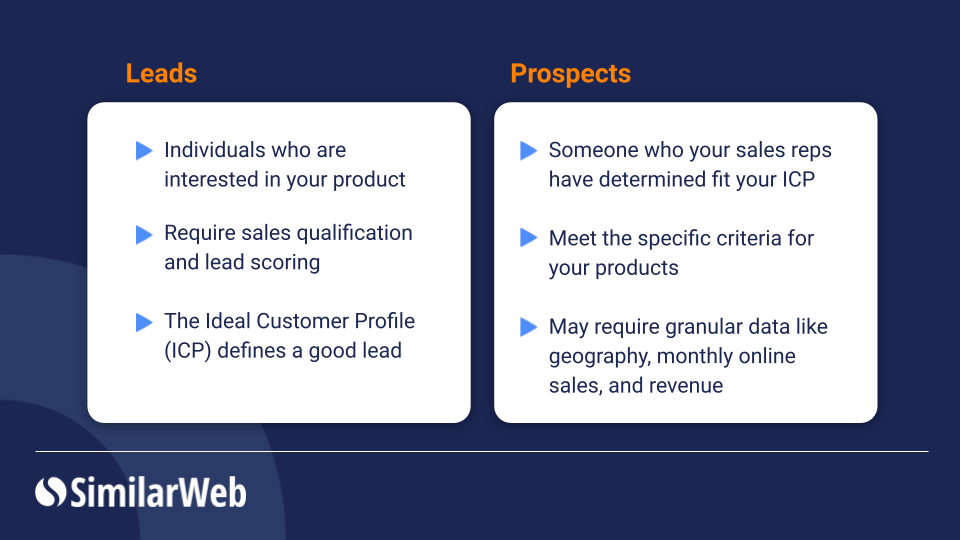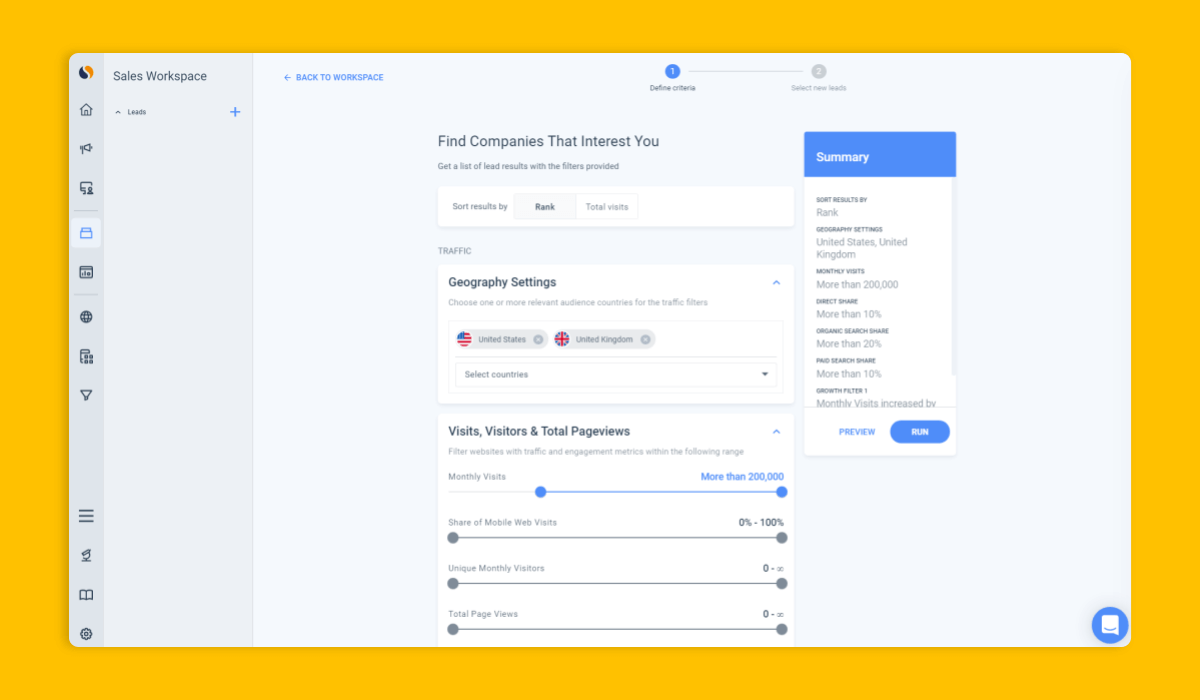The Ultimate Prospecting Guide for High-Speed Sales Organizations

If you’re looking for a way to get more leads faster, you’re not alone.
Consider this: unproductive prospecting takes up about 50% of B2B sales teams’ time. Taking a step back and adjusting your sales prospecting strategy has the power to dramatically boost your efficiency.
In this sales prospecting guide, we cover everything you need to know (or need to remember) to hone your sales prospecting funnel. Ready to speed up the sales process, close more deals, and hit your targets faster? Keep reading and add this to your bookmarks for fast access.
Sales prospecting 101
Before we dive into the step-by-step guide, let’s review some basic definitions.
What is sales prospecting?
Sales prospecting is the process of identifying potential customers or potential buyers (also called prospects) who fit your ideal customer profile (ICP) with the goal of adding them to your sales funnel. Once you’ve identified your prospects and added them to your CRM, your objective is to nurture them until they are ready to convert into paying customers.
Leads vs. prospects: What’s the difference?
Although leads and prospects play a similar role in the sales cycle, they have significant differences worth spelling out.
Leads are individuals who have indicated an interest in your company’s product or service by filling out a lead form with their contact information or interacting with your content (i.e. reading blog posts, subscribing to your weekly newsletter, downloading an eBook, sharing your LinkedIn post with their network, and so on).
Although lead generation is important, it does not guarantee that you will get quality leads that are a good fit for your company. That’s why strategic sales teams devote resources to the lead qualification process and lead scoring, as these processes enable them to narrow down inbound leads to those that fit their ideal customer profile (ICP).
On the other hand, a prospect is someone who your sales reps have already determined matches your ICP based on specific criteria, such as their industry, company size, position, need, and purchasing authority – even if they never displayed an interest in your company.
Many sales teams have even more granular criteria for their ideal prospects, such as the regions where they conduct business, the volume of their website traffic, monthly online sales, and revenue. Although having this information makes prospecting far more effective, only certain types of solutions offer these kinds of insights.
Sales prospecting is key for building a successful sales pipeline, ensuring your sales reps are using their time efficiently, and ultimately, closing more deals.
With a thoughtful and strategic approach to your sales prospecting efforts, you can zero in on the prospects that have the greatest chances of becoming paying customers. This helps you to fill your quotas and hit your targets faster. Prospecting also allows you to hold meaningful conversations with potential customers and provide them with real value, setting the groundwork for long-term retention. Whether it’s a cold email or a cold call, or a contact further down the line, you will be better equipped when you have the right messaging.
Not all sales prospecting processes are created equal. Here are five steps to optimize your sales prospecting funnel to close more deals:
1. Research
During the first step, you’ll research your prospect list to see who qualifies to enter the sales funnel. Doing research also prepares you to offer potential prospects real-world value. To that end, you’ll want to answer the following questions:
- Does the prospect’s company fit our ICP? Starting with demographics, determine if the company checks off your “must-have” boxes. For example, do you sell to their industry? Is the company the right size? Do they operate in the right regions?
- What constraints does the prospect face? The two most common constraints are budget and timeline. If the prospect doesn’t have enough budget to buy your product or service, or if they are working on an unreasonably fast or slow timeline, these can be deal-breakers for you. Find out your obstacles early to determine if the deal is worth pursuing.
- What are your prospects’ pain points? You can’t provide a prospect value unless you understand their industry, challenges, pain points, needs, and business objectives. If you’re not familiar with their industry, you’ve got some homework to do.
- Are they “warm” or “cold”? You’ll need to know how familiar a new prospect is with your offering before you’ll know how to personalize your first sales pitch. With “warm” prospects who already know what you do, acting as a consultant or advisor who can provide valuable information about their industry and pain points will help you establish a strong rapport. On the other hand, “cold” leads will need more education on what your company offers.
After researching prospects and deciding how to approach them, you’ll need to prioritize which ones your reps should communicate with first. Continually prioritizing your prospects as new ones enter the pipeline will help you ensure the biggest potential deals and those that promise to provide the greatest lifetime value remain at the top.
2. Identify decision-makers
Most often, the person at the other end of the prospecting process will be either an influencer or a decision-maker. While only decision-makers have the authority to decide if their company will buy your product or service, influencers are still valuable. Often, they are the ones who would be using your product or service, so helping them realize a true need for your offering is still crucial.
If your prospect is an influencer, you’ll want to ask them to invite a decision-maker into the conversation. If you approach both conversations right, your influencer can help you close the deal.
3. Schedule a meeting
If you decide to move forward with a prospect and have a discovery call, you should use the first contact to accomplish a few key goals:
- Establish a rapport
- Gain a deep understanding of their pain points, business challenges, and primary objectives
- Provide a high-level explanation of how your product or service solves these challenges
The key to effective discovery phone calls with new prospects is to be friendly and personal, so the prospects feel comfortable and aren’t itching to get off the phone. Listen more than you talk – the purpose of this call is really for you to understand the prospect’s needs and further qualify them. And when you finally discuss your company’s offering, keep it brief so the prospect will be interested enough in scheduling a follow-up meeting, where you can give a full sales pitch.
4. Qualify your prospect
By this stage, you should have a pretty solid understanding of your prospects’ needs and pain points. Now, you can decide if you will continue to follow up with the prospect or not. The stage is key for effective prospecting in real-time.
When qualifying a prospect, you’ll want to cover the following three points:
- Need: Do they truly fit your ICP? Can your product or service fulfill their needs?
- Budget: Does the prospect have the budget to pay for your offering? Also, does the perceived value of your offering match the price point? This is something potential customers will weigh on their end.
- Authority: Does the prospect have the authority to allocate a budget for your company’s product or service? As we mentioned already, lack of authority doesn’t need to be a deal-breaker if the prospect’s company fits your ICP. Simply ask to be connected to someone with decision-making authority.
5. Close the deal
After you have qualified the prospect, demonstrated your offering’s functionality and value, and aligned with them on priorities and goals, hopefully, the prospect is ready to close the deal. Depending on your industry, offering, and price point, it can be weeks, months, or even a year before a prospect is ready to close. B2B sales, for example, differs greatly from B2C sales.
Whenever the deal is closed, that is the time for sales professionals to celebrate. These steps enable you to reach your individual and team sales goals, win the company more revenue, and crush your targets.
Give your prospecting a boost with account-based marketing
The most successful approach to prospecting is one that takes into account each individual prospect’s context and “temperature.” Not only should your sales reps understand who the new prospect is and what their challenges are, but they should also tailor their communication to the prospect’s level of familiarity with your offering.
You can achieve this by combining account-based marketing tactics with cold outreach. This is an effective sales approach.
Account-based marketing (or ABM) is an outbound growth strategy in which marketing and sales teams work together to mutually identify, target, and convert high-value accounts with personalized content. This is also one of the many important digital marketing terms you need to know.
By integrating account-based marketing practices into your sales prospecting approach, you can help qualified prospects generate authentic interest in your offering and “warm” them up with targeted, valuable content.
You can do this by:
- Targeting them with industry- or vertical-specific ads and content
- Adding them to your network and interacting with them on social media
- Producing a podcast, video, or blog and inviting them to be featured with an interview
- Directing them to custom landing pages that address their specific needs, questions, and concerns
- Inviting prospects to relevant in-person meetings or digital events
By establishing a connection and providing highly-relevant information to your prospects, you can initiate the education process before and throughout your outreach and follow-up activities. Once your prospect begins seeing your company’s content as a valuable source of information, it will be easier to adopt an advisor/consultant role.
The sales prospecting tool that will give your team an edge
There are many sales prospecting tools out there, each with similar capabilities, give or take. They all promise to simplify prospecting by increasing processes efficiency or automating outreach. But to truly make a difference, you need reliable data.
Similarweb’s Sales Intelligence solutions give sales teams instant access to data that helps them identify qualified prospects, get high-value insights, and close deals faster. It boosts sales opportunities by 30% more and win rates by 10%.
Discover how to generate new leads based on your specific criteria by watching this how-to video:
How does our solution do it?
By enriching your leads with digital performance metrics, Similarweb helps you narrow your focus on prospects that fit your ICP. It saves you valuable time and resources by automatically qualifying your prospects with granular performance metrics. For example, beyond the typical demographic data, you may want to know if your prospect:
- Makes a certain number of online sales per month
- Maintains a specific volume of traffic
- Already works with competing vendors
- Operates in a specific region
With this data, you can identify and qualify prospects on a much deeper level before you ever even pick up the phone. Not only that, but Similarweb gives you valuable insight about a prospect’s competitors, which is sure to attract their attention and position you to serve as their trusted consultant.
Get your eCommerce prospect list
The sales prospecting guide you can always turn to
Both new and veteran sales professionals can benefit from reviewing the basics now and then.
Although the pressure in sales is always on, high-speed teams know the key to closing more deals faster is taking the time to do prospecting right. By adopting the methods and tools mentioned in this sales prospecting guide, success is within reach.
This blog post was written in collaboration with Tamara Rosin.
FAQ
What is sales prospecting?
Prospecting is finding possible customers, or prospects.
How do I start prospecting sales?
Begin with research and identifying decision-makers.
Enhance prospecting with unique data and buying signals
Try Similarweb Sales Intelligence today — free of charge













